2003 MERCEDES-BENZ SLK CLASS warning
[x] Cancel search: warningPage 276 of 304
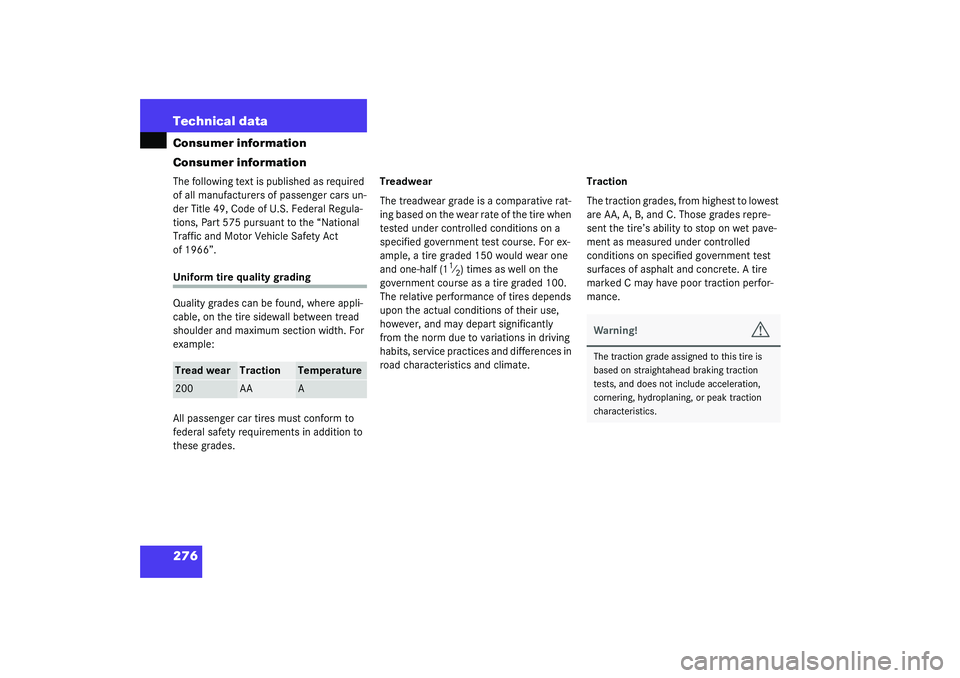
276 Technical dataConsumer information
Consumer informationThe following text is published as required
of all manufacturers of passenger cars un-
der Title 49, Code of U.S. Federal Regula-
tions, Part 575 pursuant to the “National
Traffic and Motor Vehicle Safety Act
of 1966”.Uniform tire quality grading
Quality grades can be found, where appli-
cable, on the tire sidewall between tread
shoulder and maximum section width. For
example:
All passenger car tires must conform to
federal safety requirements in addition to
these grades.Treadwear
The treadwear grade is a comparative rat-
ing based on the wear rate of the tire when
tested under controlled conditions on a
specified government test course. For ex-
ample, a tire graded 150 would wear one
and one-half (1
1⁄2) times as well on the
government course as a tire graded 100.
The relative performance of tires depends
upon the actual conditions of their use,
however, and may depart significantly
from the norm due to variations in driving
habits, service practices and differences in
road characteristics and climate.Traction
The traction grades, from highest to lowest
are AA, A, B, and C. Those grades repre-
sent the tire’s ability to stop on wet pave-
ment as measured under controlled
conditions on specified government test
surfaces of asphalt and concrete. A tire
marked C may have poor traction perfor-
mance.
Tread wear
Traction
Temperature
200
AA
A
Warning!
G
The traction grade assigned to this tire is
based on straightahead braking traction
tests, and does not include acceleration,
cornering, hydroplaning, or peak traction
characteristics.
Page 277 of 304
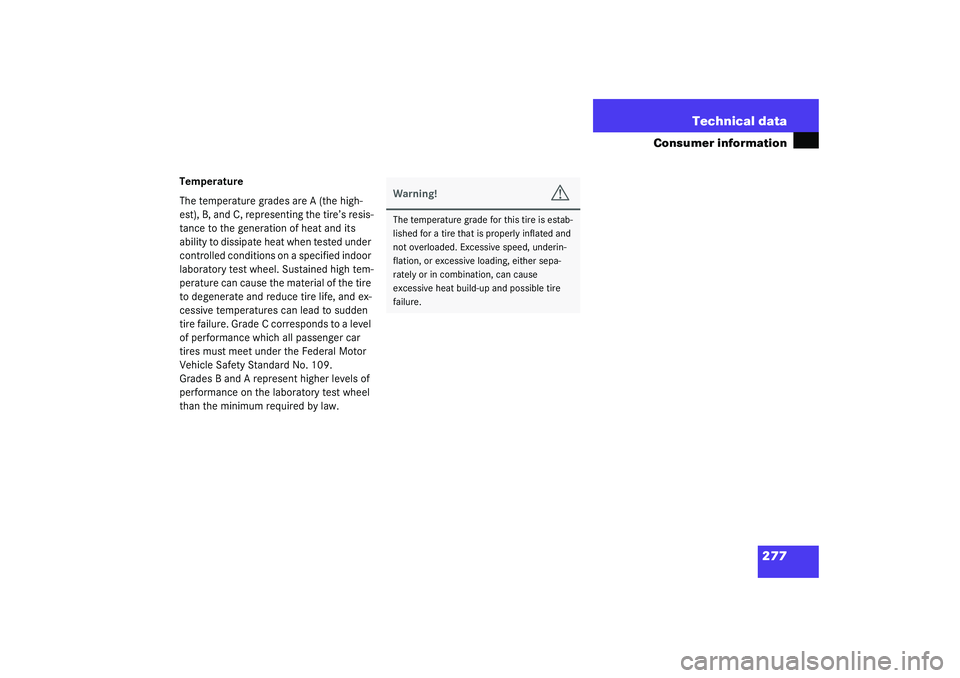
277 Technical data
Consumer information
Temperature
The temperature grades are A (the high-
est), B, and C, representing the tire’s resis-
tance to the generation of heat and its
ability to dissipate heat when tested under
controlled conditions on a specified indoor
laboratory test wheel. Sustained high tem-
perature can cause the material of the tire
to degenerate and reduce tire life, and ex-
cessive temperatures can lead to sudden
tire failure. Grade C corresponds to a level
of performance which all passenger car
tires must meet under the Federal Motor
Vehicle Safety Standard No. 109.
Grades B and A represent higher levels of
performance on the laboratory test wheel
than the minimum required by law.
Warning!
G
The temperature grade for this tire is estab-
lished for a tire that is properly inflated and
not overloaded. Excessive speed, underin-
flation, or excessive loading, either sepa-
rately or in combination, can cause
excessive heat build-up and possible tire
failure.
Page 279 of 304

279 Technical terms
ABS
(A
ntilock B
rake S
ystem)
Prevents the wheels from locking up
during braking so that the vehicle can
continue to be steered.
Alignment bolt
Metal pin with thread. The centering
pin is an aid used when changing a tire
to align the wheel with the wheel hub.
BabySmart
TM
airbag deactivation
system
This system detects if a special system
compatible child restraint seat is in-
stalled on the passenger seat. The sys-
tem will automatically deactivate the
passenger front airbag when such a
seat is properly installed (indicator
lamp
7
in the center console lights
up). See your authorized
Mercedes-Benz Center for availability.BabySmart
TM
compatible child seats
Special restraint system for children.
The sensor system for the passenger
seat prevents deployment of the pas-
senger front airbag if a BabySmart
TM
compatible child seat is installed.
BAS
(B
rake A
ssist S
ystem)
System for potentially reducing braking
distances in emergency braking situa-
tions. The system is activated when it
senses an emergency based on how
fast the brake is applied.
CAC
(C
ustomer A
ssistance C
enter)
Mercedes-Benz customer service cen-
ter, which can help you with any ques-
tions about your vehicle and provide
assistance in the event of a break-
down.CAN system
(C
ontroller A
rea N
etwork)
Data bus network serving to control ve-
hicle functions such as door locking or
windshield wiping.
Cockpit
All instruments, switches, buttons and
indicator/warning lamps in the passen-
ger compartment needed for vehicle
operation and monitoring.
Collapsible tire
An especially compact spare tire that
must be inflated with a provided air
pump before using. It should only be
used to bring the vehicle to the nearest
service station.
Cruise control
Driving convenience system for auto-
matically maintaining the vehicle speed
set by the driver.
Page 280 of 304
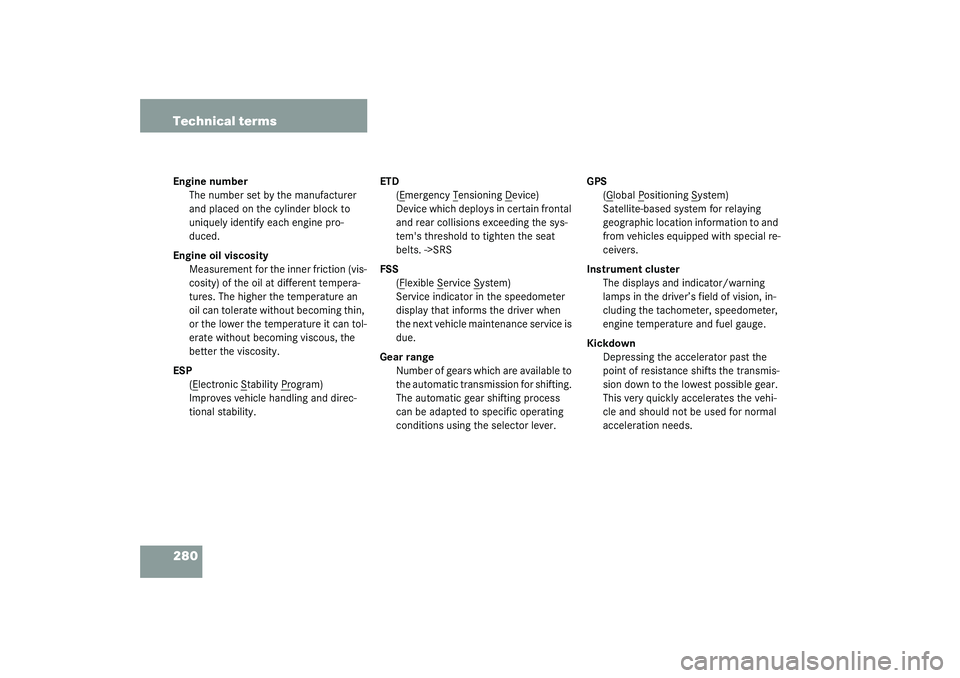
280 Technical termsEngine number
The number set by the manufacturer
and placed on the cylinder block to
uniquely identify each engine pro-
duced.
Engine oil viscosity
Measurement for the inner friction (vis-
cosity) of the oil at different tempera-
tures. The higher the temperature an
oil can tolerate without becoming thin,
or the lower the temperature it can tol-
erate without becoming viscous, the
better the viscosity.
ESP
(E
lectronic S
tability Pr
ogram)
Improves vehicle handling and direc-
tional stability.ETD
(E
mergency T
ensioning D
evice)
Device which deploys in certain frontal
and rear collisions exceeding the sys-
tem's threshold to tighten the seat
belts. ->SRS
FSS
(F
lexible S
ervice S
ystem)
Service indicator in the speedometer
display that informs the driver when
the next vehicle maintenance service is
due.
Gear range
Number of gears which are available to
the automatic transmission for shifting.
The automatic gear shifting process
can be adapted to specific operating
conditions using the selector lever.GPS
(G
lobal P
ositioning S
ystem)
Satellite-based system for relaying
geographic location information to and
from vehicles equipped with special re-
ceivers.
Instrument cluster
The displays and indicator/warning
lamps in the driver’s field of vision, in-
cluding the tachometer, speedometer,
engine temperature and fuel gauge.
Kickdown
Depressing the accelerator past the
point of resistance shifts the transmis-
sion down to the lowest possible gear.
This very quickly accelerates the vehi-
cle and should not be used for normal
acceleration needs.
Page 285 of 304
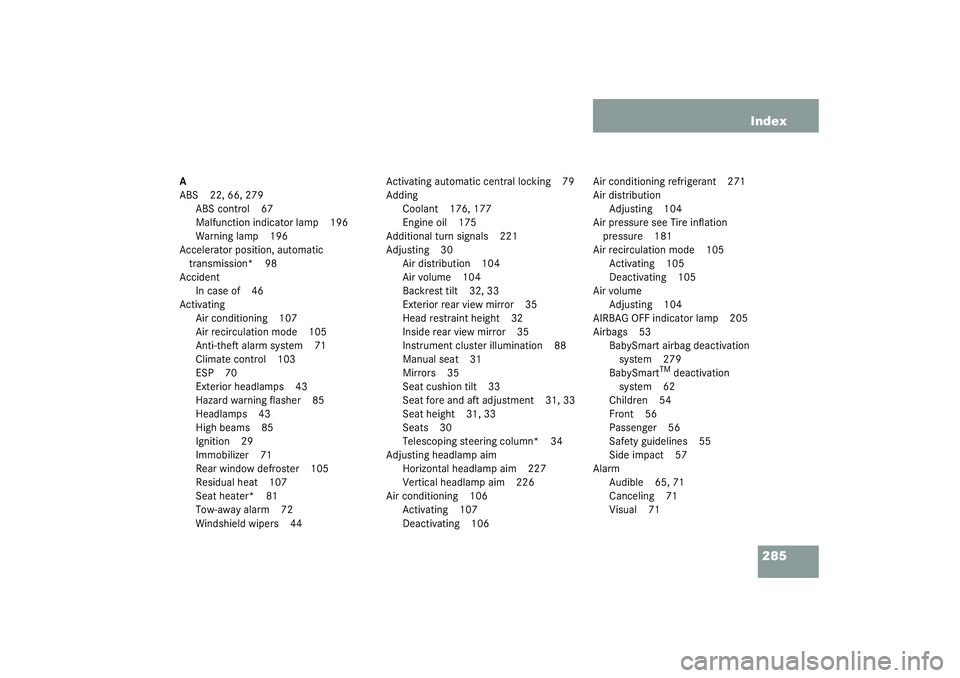
285 Index
A
ABS 22, 66, 279
ABS control 67
Malfunction indicator lamp 196
Warning lamp 196
Accelerator position, automatic
transmission* 98
Accident
In case of 46
Activating
Air conditioning 107
Air recirculation mode 105
Anti-theft alarm system 71
Climate control 103
ESP 70
Exterior headlamps 43
Hazard warning flasher 85
Headlamps 43
High beams 85
Ignition 29
Immobilizer 71
Rear window defroster 105
Residual heat 107
Seat heater* 81
Tow-away alarm 72
Windshield wipers 44Activating automatic central locking 79
Adding
Coolant 176, 177
Engine oil 175
Additional turn signals 221
Adjusting 30
Air distribution 104
Air volume 104
Backrest tilt 32, 33
Exterior rear view mirror 35
Head restraint height 32
Inside rear view mirror 35
Instrument cluster illumination 88
Manual seat 31
Mirrors 35
Seat cushion tilt 33
Seat fore and aft adjustment 31, 33
Seat height 31, 33
Seats 30
Telescoping steering column* 34
Adjusting headlamp aim
Horizontal headlamp aim 227
Vertical headlamp aim 226
Air conditioning 106
Activating 107
Deactivating 106Air conditioning refrigerant 271
Air distribution
Adjusting 104
Air pressure see Tire inflation
pressure 181
Air recirculation mode 105
Activating 105
Deactivating 105
Air volume
Adjusting 104
AIRBAG OFF indicator lamp 205
Airbags 53
BabySmart airbag deactivation
system 279
BabySmart
TM deactivation
system 62
Children 54
Front 56
Passenger 56
Safety guidelines 55
Side impact 57
Alarm
Audible 65, 71
Canceling 71
Visual 71
Page 287 of 304

287 Index
Battery discharged
Jump starting 247
Battery, vehicle 178, 245
Charging 246
Disconnecting 246
Reconnecting 246
Reinstalling 246
Removing 246
Block heater 184
Bolts
For spare wheel 207
Brake assist system (BAS) 279
Brake fluid 170, 271
Brake lamp bulbs 222
Brake lamp, high mounted 222
Brakes 160
Warning lamp 198
Break-in period 158
Bulbs, replacing 221
Additional turn signals 221
Backup lamps 222
Brake lamps 222
Fog lamps 221
Front lamps 221
High beam 221
High mounted brake lamp 222License plate lamps 222, 226
Low beam 221
Parking lamps 221, 222, 224
Rear fog lamp 222
Rear fog lamps 225
Side marker lamps 221, 225
Standing lamps 221, 222, 224
Tail lamp assemblies 222, 225
Turn signal lamps 221, 222
Xenon* headlamps 223
Button
Audio system 115
C
CAC (Customer Assistance Center) 279
California
Important notice 9
Calling up
Service indicator 186
CAN system 279
Capacities
Fuels, coolants, lubricants, etc. 269
Cargo area see Cargo compartment 77
Cargo compartment
Trunk 77
Casette mode
Playing cassettes 118Catalytic converter 166
CD changer* 120, 209
CD mode 120
Center console 23
AIRBAG OFF indicator lamp 205
Lower part 24
Storage compartment 140
Upper part 23
Central locking
From inside 80
Unlocking from inside 80
Certification label 258
Changing CDs 120
Charging
Vehicle battery 246
CHECK ENGINE malfunction indicator
lamp 199
Checking
Coolant level 170, 176
Oil level 170, 172
Tire inflation pressure 170
Vehicle lighting 170
Checking engine oil level
Via engine oil level indicator 173
Via oil dipstick 173
Page 289 of 304

289 Index
Cruise control lever 136
For cruise control 136
Cup holder 140
Cleaning 191
Customer Assistance Center (CAC) 279
D
Daytime running lamp mode 83
Deactivating
Air conditioning 106
Air recirculation mode 105
Alarm 71
Anti-theft alarm system 71
Climate control 103
Cruise control 137
ESP 70
Hazard warning flasher 85
Headlamps 48
Immobilizer 71
Rear window defroster 105
Residual heat 107
Seat heater* 81
Tow-away alarm 72
Deactivating automatic central
locking 79
Deep water see Standing water 165
DefoggingWindshield 109
Defrosting 108
Difficulties
While driving see Problems while
driving 45
With starting 41
Direction of rotation (tires) 181
Discharged battery
Jump starting 247
Disconnecting
Vehicle battery 246
Display elements
Audio system 112
Displays
Service indicator 185
Door unlock
With Tele Aid 151
Doors
Opening from inside vehicle 78
Opening from outside 75
Downhill driving
Cruise control 137
Downshifting 92, 94
Drink holder see Cup holder 140
Drinking and driving 159
DrivingGeneral instructions 37, 159
In winter 164
Problems 45
Safety systems 66
Through standing water 165
Traveling abroad 165
Driving instructions 159
Driving off 161
Driving safety systems
ABS 66
BAS 68
ESP 68
Driving systems 136
Cruise control 136
Driving safety systems 66
E
Electrical fuses 253
Electrical system
Technical data 266
Electronic Stability Program see ESP 22,
68
Electronic stability program see ESP 280
Emergency call system 145
Requirements 145
Page 290 of 304
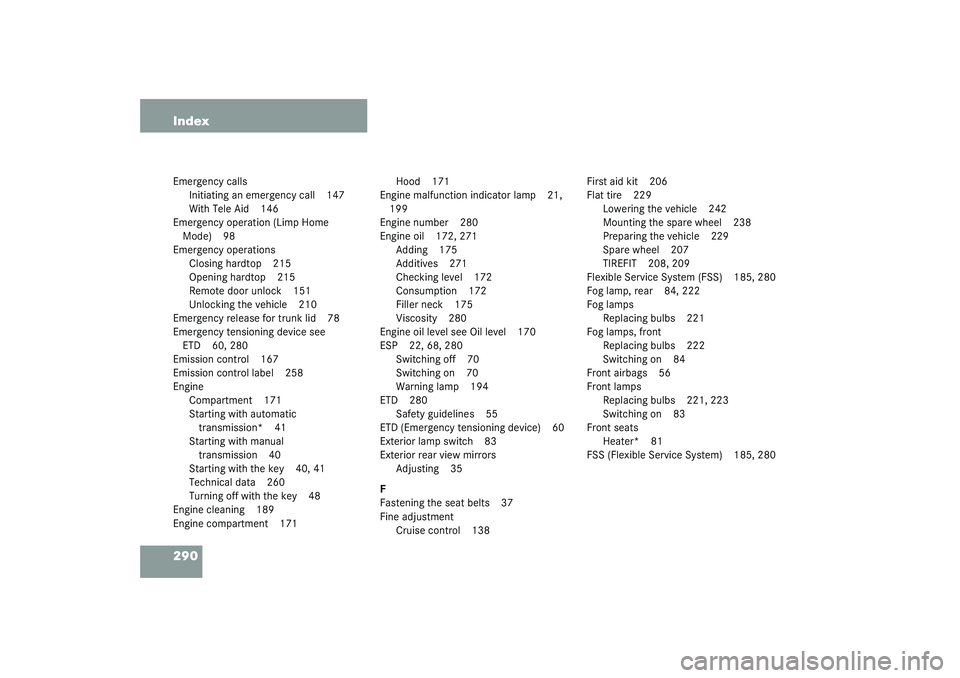
290 IndexEmergency calls
Initiating an emergency call 147
With Tele Aid 146
Emergency operation (Limp Home
Mode) 98
Emergency operations
Closing hardtop 215
Opening hardtop 215
Remote door unlock 151
Unlocking the vehicle 210
Emergency release for trunk lid 78
Emergency tensioning device see
ETD 60, 280
Emission control 167
Emission control label 258
Engine
Compartment 171
Starting with automatic
transmission* 41
Starting with manual
transmission 40
Starting with the key 40, 41
Technical data 260
Turning off with the key 48
Engine cleaning 189
Engine compartment 171Hood 171
Engine malfunction indicator lamp 21,
199
Engine number 280
Engine oil 172, 271
Adding 175
Additives 271
Checking level 172
Consumption 172
Filler neck 175
Viscosity 280
Engine oil level see Oil level 170
ESP 22, 68, 280
Switching off 70
Switching on 70
Warning lamp 194
ETD 280
Safety guidelines 55
ETD (Emergency tensioning device) 60
Exterior lamp switch 83
Exterior rear view mirrors
Adjusting 35
F
Fastening the seat belts 37
Fine adjustment
Cruise control 138First aid kit 206
Flat tire 229
Lowering the vehicle 242
Mounting the spare wheel 238
Preparing the vehicle 229
Spare wheel 207
TIREFIT 208, 209
Flexible Service System (FSS) 185, 280
Fog lamp, rear 84, 222
Fog lamps
Replacing bulbs 221
Fog lamps, front
Replacing bulbs 222
Switching on 84
Front airbags 56
Front lamps
Replacing bulbs 221, 223
Switching on 83
Front seats
Heater* 81
FSS (Flexible Service System) 185, 280